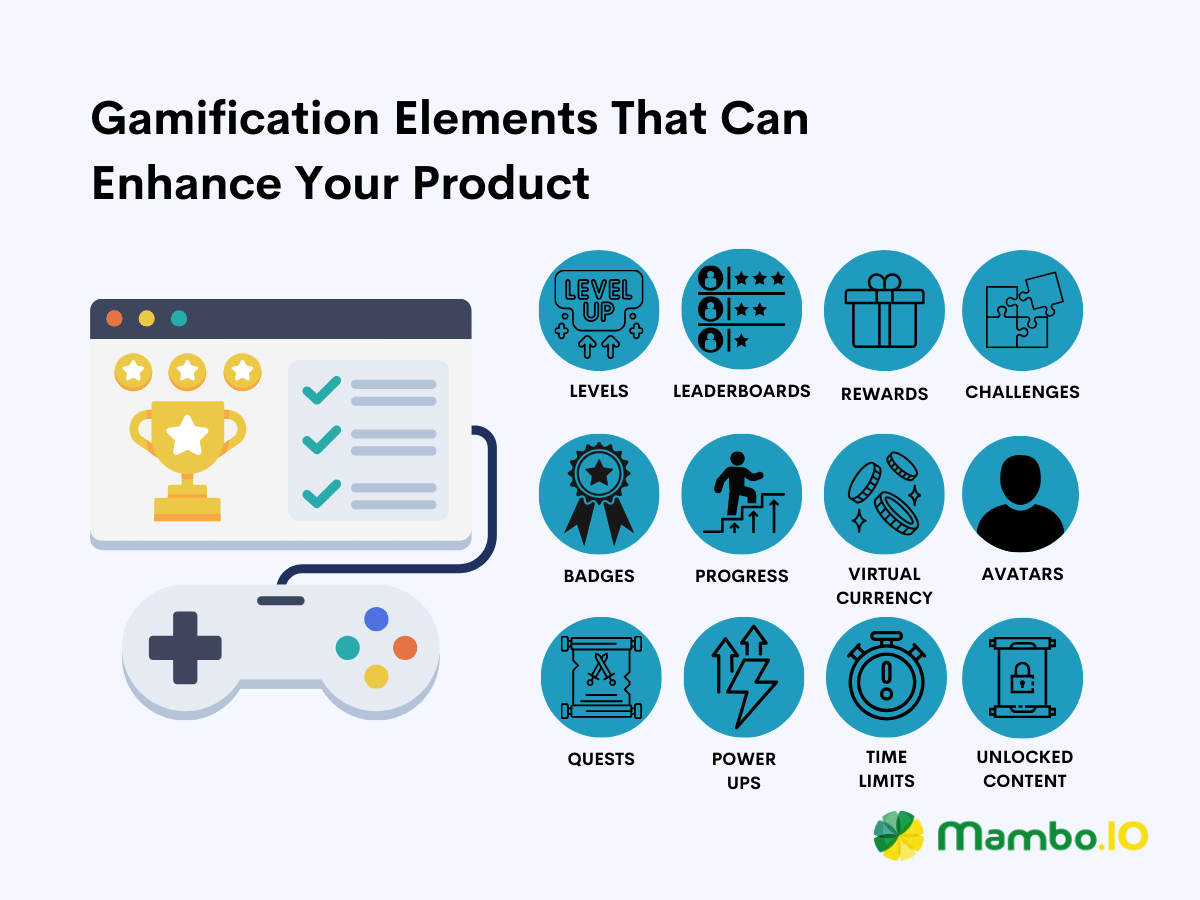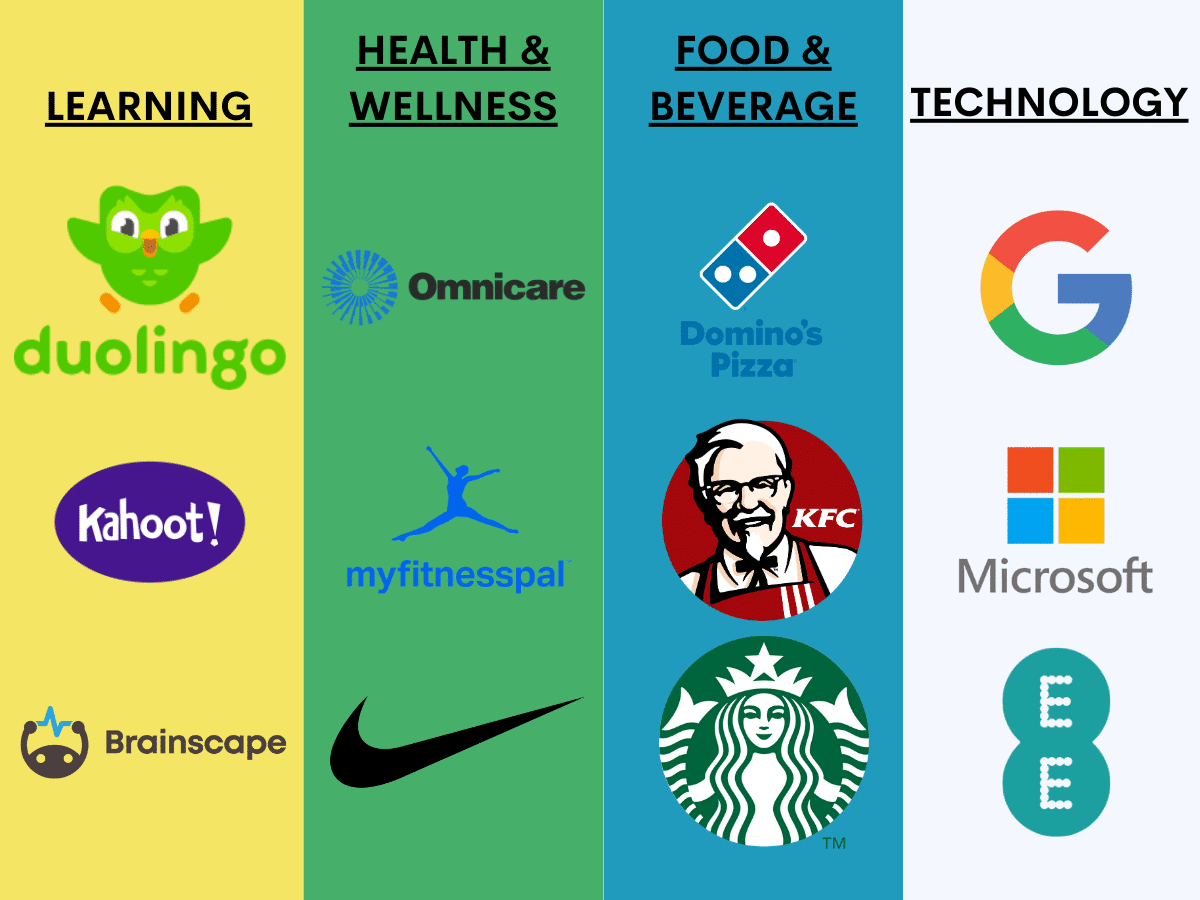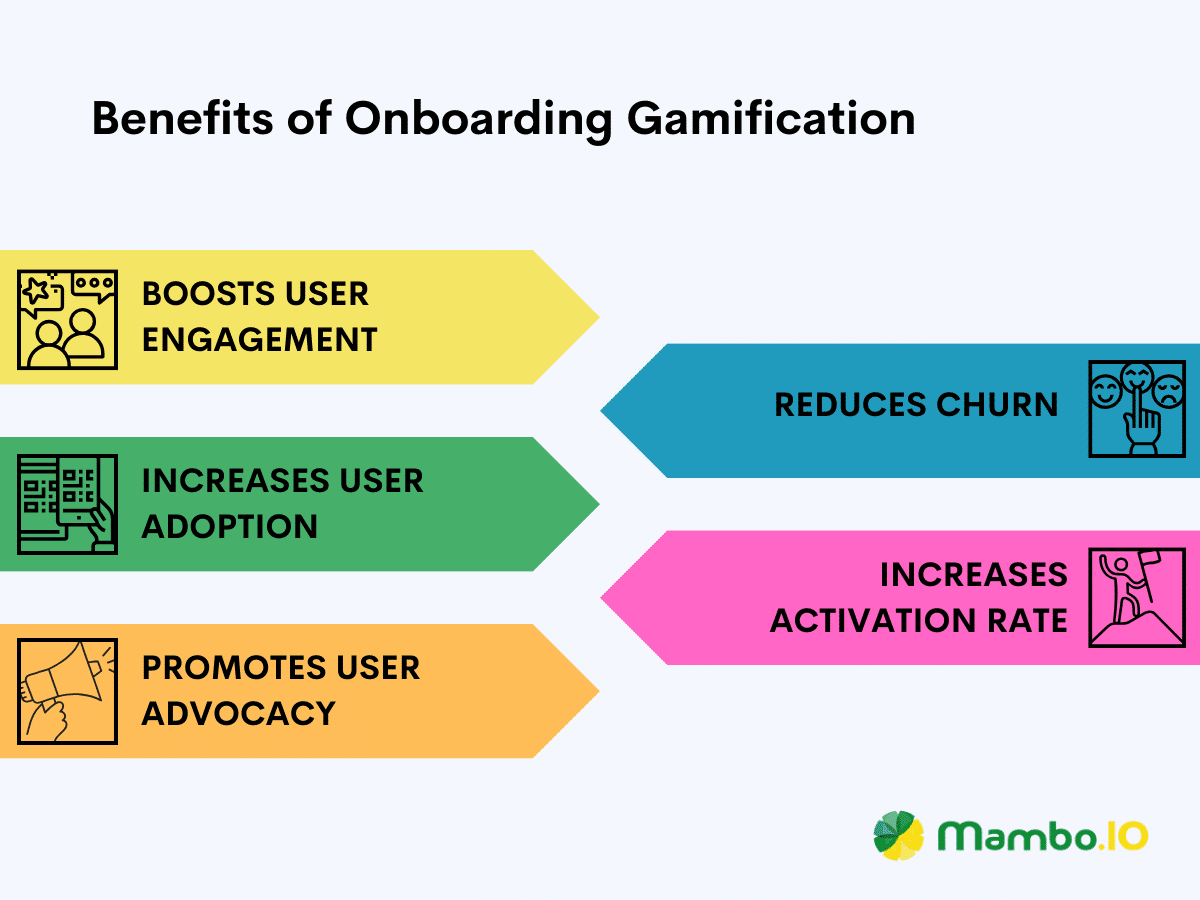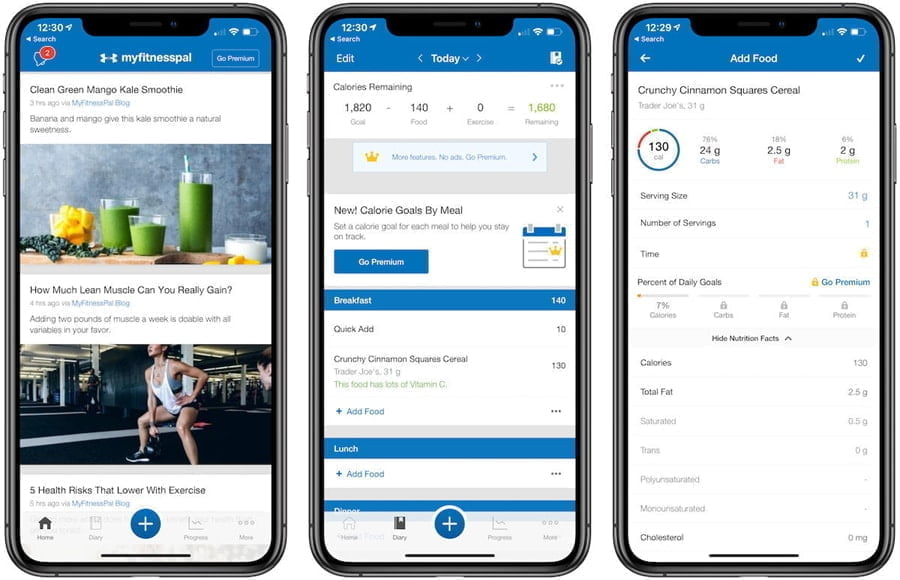How Would A Digital Product Manager Benefit From Gamification?
As a digital product manager, you’re tasked to improve the user engagement of your digital product. 86% of buyers nowadays are willing to pay more for a better user experience, which is critical to retaining customers. Faced with this overwhelming digital product management task, how will a product manager like you solve this problem? We have an answer for you: gamification for product management.
Let’s discuss compelling reasons why a digital product manager like you can benefit from gamification.
Table of Contents
- Understanding gamification as a digital product manager
- How would a digital product manager benefit from gamification?
- #1. Improved user engagement and retention
- #2. Positive behavioural change
- #3. A more enjoyable onboarding process
- #4. Effective data and feedback collection
- #5. A bustling sense of community
- #6. Strong motivator for goal achievement
- Intrinsic motivation over extrinsic incentives
- Gamification elements for better user motivation
- #7. Free-flowing insights into user preferences and behaviour patterns
- #8. Better brand loyalty and advocacy
- Digital product manager: gamification examples to get inspiration from
- Improve as a digital product manager and explore gamification for product management today
- Machine Learning In Finance: 12 Essential Applications
- How To Create Interactive Compliance Training For Bank Employees
- How Fintech Apps Are Using Gamification To Increase User Engagement
- Top Gamification Companies for Employee & Customer Engagement
Download your free
“Gamification Guide”
Get your PDF now and start transforming your approach to digital engagement!
Understanding gamification as a digital product manager
Gamification is a strategy employed in digital product management to enhance user engagement in a product or service. It borrows elements from game design and integrates features like rewards and challenges into digital products.

If gamers get continuously hooked through points, badges, and level-ups, why not apply similar mechanics to a product? The same elements, when applied to a product, is an excellent way for any digital product manager to implement the same effect. More importantly, it fosters healthy competition among users, boosting their commitment and interest in the product.
Gamification is more than just adding game elements to your product. It’s more about creating an immersive experience that taps into human psychology, motivation, and competitiveness. Integrating relevant mechanics like points, badges, challenges, and leaderboards can transform routine interactions into exciting journeys. For digital product managers, understanding the principles behind gamification is the first step toward maximising its potential.
How would a digital product manager benefit from gamification?
As a digital product manager, it would be in your best interest to consider looking deeper into gamification. It’s an effective strategy that can significantly improve different aspects of your digital product management and product development.
#1. Improved user engagement and retention
User engagement is pivotal in transforming users into loyal customers and brand advocates. With the help of gamification, you can improve your product’s appeal and gratification. This will result in a substantial uptick in user engagement and elevated user adoption and retention. These critical metrics are what any effective digital product manager will aim for to drive sustained success for their products.
Gamification is a digital product manager’s dynamic tool for keeping users hooked by making product interactions more exciting. Users are more likely to be motivated to complete tasks and achieve milestones if they encounter reward systems. When they’re incentivised, they’re inclined to accomplish even the most mundane in-app tasks because of the rewards waiting for them.
Gamification as a productivity booster
According to Zippia, incorporating gamified elements into a work environment resulted in an impressive 48% surge in employee engagement. This statistic shows how powerful gamification can be when used correctly by an effective digital product manager. Here, take a look at some of the famous companies nowadays that embraced gamification for better customer and employee engagement:

#2. Positive behavioural change
Effective digital product managers know how potent gamification is as a tool for encouraging long-lasting behavioural change. A Prosper Insights & Analytics study highlights gaming as one of the most popular activities today. It reveals that 50.7% of U.S. adults play games on smartphones and tablets. Moreover, 63.1% of the Gen-Z demographics play games on their devices.
If gaming is such a powerful driver, why don’t we reuse the same impulses for other purposes?
Behavioural change is a formidable challenge, but gamification is an attractive and defining solution if you’re a digital product manager. Whether you’re nudging them towards productive actions or healthy habits, gamified experiences can incentivise and reinforce positive behaviours. Any digital product manager can leverage this approach to steer users toward improved outcomes, benefiting users and the business.
Download your free
“108 Gamification Elements and Mechanics”
Get your cheat sheet and have a quick reference at your fingertips!
#3. A more enjoyable onboarding process
Onboarding is one of the most crucial points users must go through whenever they decide to use a product. Unfortunately, many digital products fail to engage users with their onboarding solutions. When this happens, they’re more likely to abandon the onboarding process. This can be detrimental because they can do so before thoroughly learning how to use the product.
Gamifying the onboarding process
The goal of any digital product manager for customer onboarding is to provide value to users as soon as possible. Doing so increases the likelihood of them returning to your digital products and quickly adopting it into their daily workflow. Unfortunately, this learning process can be overtly dull. Not only that, it can be challenging to hold their attention long enough to entice them to use your product.
So, how can a digital product manager like you solve this dilemma? By incorporating gamification into your user onboarding strategies!
Product onboarding and learning curves can often be daunting for users, especially the new ones. Fortunately, you can include gamification as one of your user onboarding tools to turn these processes into a fun and exciting journey. Digital product managers can facilitate a smoother learning journey by creating interactive tutorials, quizzes, and challenges. Ultimately, this solution can reduce the frustration users experience during onboarding and prevent them from dropping out of the process.

#4. Effective data and feedback collection
Effective data collection is necessary to make informed decisions, regardless of the size of your organisation.
Many digital product managers treat data as a superpower that can directly affect the state and success of product adoption. They gather these data from various sources, such as market research, customer feedback, and more. Data is such an important puzzle piece for the product development and product management process. And the higher the data quality, the better it is for the digital product and its existing users.
Importance of data collection as a digital product manager
According to McKinsey Global Institute’s market research, data-driven organisations are 23 times more effective in acquiring new customers. They’re also six times more likely to retain customers and 19 times more likely to achieve profitability. As a product manager doing their best to develop a successful digital product, this statistic is an eye-opener.
The data and feedback you collect allow you to know the landscape on which your digital products lie. It can also give you the necessary insights about your target audience’s demographics, habits, preferences, and pain points. These things are critical in developing a profitable and successful digital product that delivers user value.
Leveraging gamification for data collection as a digital product manager
Gamification can help any digital product manager entice users to provide valuable insights crucial for smoother product development. This sentiment is especially true if you’re working with prominent companies dealing with big data.
As shown below, there are also some compelling reasons why a digital product manager should use gamification for data collection.

Some elements you can incorporate to improve data and feedback collection for lighter product management workloads are as follows:
- Interactive surveys and quizzes
- Progress tracking
- Milestone badges
- Leaderboards
- User challenges
#5. A bustling sense of community
Gamified communities have been prevalent on the internet even before the rise of the modern-day apps we see today. Successful online platforms like Reddit have used upvotes, badges, and leaderboards to drive community engagement. Even popular social media platforms like Facebook and Instagram use the number of followers and likes to influence their members.
If you want to create a solid community surrounding your digital product, there’s no better way to adopt gamification. Gamification uses the power of psychology and motivational science to create meaningful experiences for every member of your online community. It can delight customers, boost employee productivity, and even engage partners!
Ultimately, it allows digital product managers to create a thriving culture and community. One where users feel valued, challenged, and rewarded for their actions and behaviours.
#6. Strong motivator for goal achievement
Here’s a tough pill to swallow as a digital product manager: work can sometimes feel unrewarding for most people. They’d rather distract themselves from their current activities because they don’t have the intrinsic motivation to pursue their goals. Let’s face it: us humans only have limited willpower, and we can only do so much with it. This is the harsh reality most people nowadays face, one that digital product managers must be aware of.
Extrinsic motivation for optimal goal achievement
Gamification provides the extrinsic motivation to engage users to achieve their goals, no matter how big or small it is. Through gamification, digital product managers can set attainable objectives and reward users upon completion. Doing so not only maintains user interests but also instils a sense of accomplishment. Ultimately, it can motivate users to continuously utilise your product to both of your benefits.

Intrinsic motivation over extrinsic incentives
Intrinsic motivation is more powerful than extrinsic motivation because it helps the development of deeper personal values for the user. When utilised correctly in the context of gamification, it will inevitably lead to higher engagement.
Leveraging it can also lead to higher engagement and deeper personal values for the end user. More importantly, it cultivates growth in terms of well-being and satisfaction for both parties.
So what’s the solution? Should you abandon one for the other?
This is where gamification shines the brightest because it can simultaneously foster intrinsic and extrinsic motivation if implemented correctly. Gamifying boring software and platforms doesn’t make them more engaging or relevant; it just makes them more enjoyable. But with the right gamification elements, design, and content, it can effectively promote deeper values and motivation towards users.
Gamification elements for better user motivation
Here are some gamification elements a digital product manager like you can leverage to motivate your users:
- Progress tracking
- Achievement badges
- Goal-setting challenges
- Daily streaks
- Virtual rewards
- Levelling up
- Leaderboards
#7. Free-flowing insights into user preferences and behaviour patterns
Understanding user preferences and behaviour patterns is a goldmine for product improvement. If you want to be a successful digital product manager, you need to know two important pieces of data. Your user’s wants and needs and their corresponding actions to achieve them. Once you’ve got those figured out, you can significantly improve their level of satisfaction towards your product.
You can use gamification mechanics to encourage them to make choices that reveal their preferences and decision-making. Such valuable information can guide any digital product manager to enhance their products and make personalised experiences for each user.
#8. Better brand loyalty and advocacy
Brand loyalty is such a game-changer for many businesses today. The competition in the current digital landscape is fierce, regardless of what industry your organisation is a part of. You’ll need all the help you can get to ensure your customers are loyal product advocates.
But how does a successful digital product manager do this?
Gamification is an instrument that can bring forth a positive, lasting effect on your customers and brand. When this happens, you can expect them to form a stronger and meaningful connection with your brand and product.
Features like exclusive rewards, personal offers, and experiences can easily be a gateway for them to strive for different rewards.
How can a digital product manager use gamification to drive brand loyalty and advocacy?
Gamification can be a wild card that can significantly drive revenue growth, brand loyalty, and advocacy towards your digital product. That sentiment will be more prominent since artificial intelligence (AI) has overgrown recently. Because of this, identifying the sweet spot between challenge and proportionate reward for each user will be so much easier.
Do you want to know how a digital product manager like you can improve improve customer loyalty through gamification? Here’s how, according to Forbes:
- Put your first-party data to work. Access to first-party data is necessary to create balanced, gamified offers and experiences.
- Apply artificial intelligence and machine learning (ML). Applying AI and ML can ensure high customer engagement by providing rewards balanced with the level of effort.
- Provide persistent reminders of progress and rewards. Exert some effort in persistently reminding your users about their progress and the rewards that await them.
Digital product manager: gamification examples to get inspiration from
Here are some gamification examples that can change your digital product manager’s mind regarding the power of gamification.
#1. Kahoot!
Kahoot! It is an interactive learning platform widely used for educational purposes. It leverages gamification principles like competition, rewards, and instant feedback to create an interactive and enjoyable learning experience.

Souce: PCMag
#2. MyFitnessPal
MyFitnessPal is a mobile calorie-counter app designed to help individuals track their nutrition, fitness, and overall wellness. This app encourages users to commit to their fitness goals through calorie budgeting and food logging.

Source: Fusion Informatics
#3. Lazada
Lazada is one of the most successful e-commerce platforms in Southeast Asia. They keep their customers hooked through gamification elements like flash sales, virtual currencies, vouchers, challenges, missions, and more.

Source: Google Play
Are you enjoying these examples? Check out Gamification Examples: The Ultimate List For User Engagement for more!
Improve as a digital product manager and explore gamification for product management today
Digital product managers can skyrocket their organisation’s user engagement, retention, and loyalty by integrating gamification into their product strategy. But here’s a reminder: this product management strategy is not a one-size-fits-all approach
To maximise it, you’ll need some out-of-the-box digital product manager skills. Most importantly, the help of a gamification expert is necessary to tailor your strategy to your audience, objectives, and product identity.
Mambo.io can help a digital product manager like you boost your product’s performance. We can help you harness gamification, the best tool for delivering top-quality user engagement to digital products. With the help of gamification, you can create profitable and engaging digital products or improve your digital product management process. Book a demo today to learn more!
Latest Posts
Machine Learning In Finance: 12 Essential Applications
The impact of machine learning on finance is significant. Thanks to this technology, financial institutions are now equipped to make efficient decisions. Through the analysis of data sets, machine learning […]
How To Create Interactive Compliance Training For Bank Employees
Banking compliance training isn’t just another task. It’s the stage where everything else performs. Banks must navigate a myriad of regulations and laws. After all, this is a trust-driven, high-stakes […]
How Fintech Apps Are Using Gamification To Increase User Engagement
Discover how gamification in fintech is revolutionizing financial engagement, making banking fun & boosting user loyalty.






